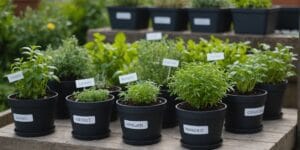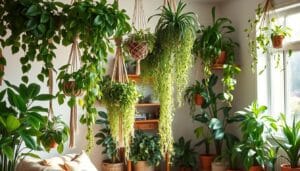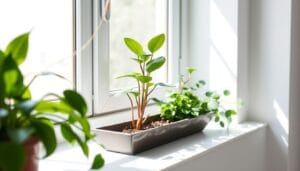Growing your own kitchen plants and herbs is fun and delicious. It lets you enjoy the freshest flavors in your cooking. An indoor herb garden is a great way to have your favorite herbs ready when you need them. It’s easier than you think to start growing herbs indoors.

Whether you’re a seasoned gardener or just starting, growing your own kitchen plants and herbs is rewarding. In this article, we’ll look at the best kitchen plants and herbs to grow at home. We’ll give you the tips and tricks you need to create a successful indoor herb garden and start growing herbs indoors.
Benefits of Growing Kitchen Plants and Herbs
Growing your own kitchen herb garden is rewarding. It offers many benefits for cooking and health. You get to have fresh flavors right at your fingertips. This lets you add a personal touch to your favorite dishes.
Some key benefits include:
- Fresh flavors: Harvest your herbs at their peak freshness and flavor, perfect for cooking and seasoning.
- Cost savings: Growing your own herbs can save you money in the long run, as you won’t have to rely on store-bought options.
- Air-purifying benefits: Many kitchen plants and herbs have air-purifying properties, making them a great addition to your home.
When choosing the best herbs to grow, consider these popular ones:
| Herb | Culinary Use | Easy to Grow |
|---|---|---|
| Basil | Pesto, salads, sauces | Yes |
| Rosemary | Roasted meats, vegetables, soups | Yes |
| Thyme | Soups, stews, meat dishes | Yes |
Adding a kitchen herb garden to your home brings many benefits. You get fresh, flavorful herbs, purify the air, and save money. With a little care, you can grow a thriving collection of herbs and improve your cooking.
Essential Equipment for Your Indoor Garden
To make your indoor herb garden thrive, you need some key items. You’ll need a good potting mix, the right containers, and a watering system. Also, think about the lighting in your space. If it’s not sunny, a grow light might be a good idea.
A well-set-up culinary herb garden can give you fresh flavors all year. Here’s what you’ll need to start:
- Containers: Pick ones that are 6-8 inches deep for your plants’ roots.
- Potting mix: Go for a high-quality mix made for indoor plants.
- Watering system: Think about a self-watering system or a moisture meter for the right moisture.
- Grow light: If your space isn’t sunny, a grow light can help your plants grow.
With the right gear, you’re on your way to a thriving indoor herb garden. It will give you fresh flavors and some greenery at home. Whether you’re growing herbs indoors for cooking or just for fun, the right tools make a big difference.
| Equipment | Description |
|---|---|
| Containers | Choose containers that are at least 6-8 inches deep |
| Potting mix | Select a high-quality potting mix specifically designed for indoor plants |
| Watering system | Consider investing in a self-watering system or a moisture meter |
| Grow light | Provides plants with the light they need to thrive |
Creating the Perfect Growing Environment
To make your kitchen herb plants thrive, you need to create the right environment. This means giving them the right light, keeping the temperature steady, and managing humidity. Most herbs like bright, indirect light, but some can handle full sun.
Herbs prefer daytime temperatures between 65-75°F and cooler nights around 55-65°F. They also like a low humidity setting. An indoor herb garden does well in a spot with good air flow. This helps prevent diseases.
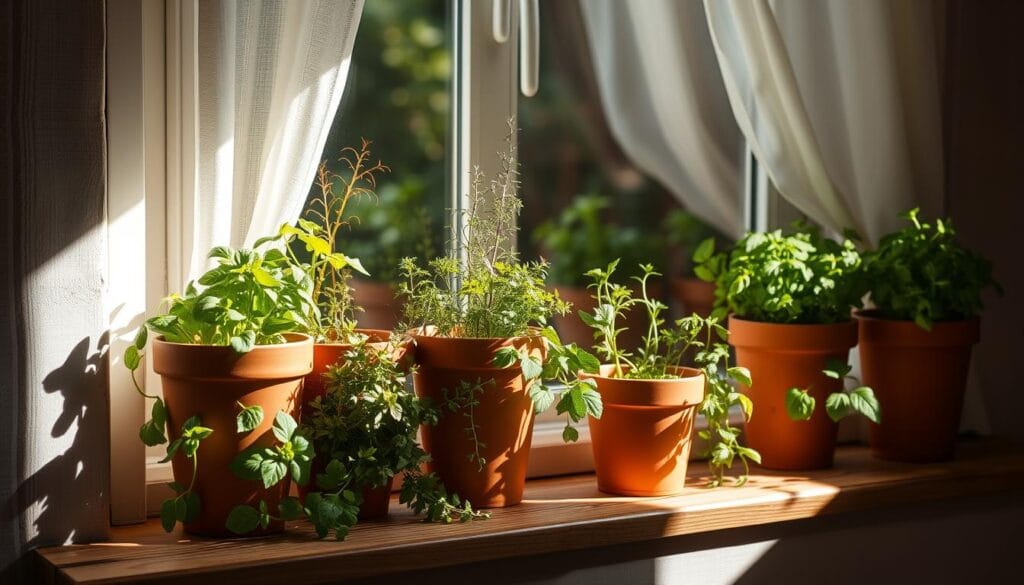
- Lighting: Make sure your herbs get the right amount of light, whether it’s from the sun or a lamp.
- Temperature: Keep the temperature consistent for the type of herb you’re growing.
- Humidity: Keep humidity levels low for your herbs.
By creating the perfect environment for your herbs, you can enjoy a lush indoor garden. It will give you fresh flavors and scents all year.
Best Culinary Herbs for Beginners
Starting with kitchen plants and herbs is key. For newbies to indoor herb garden, begin with basil, mint, cilantro, and parsley. These are easy to grow and add flavor to many dishes. Basil is great for pesto and caprese salads, while mint is perfect for drinks and desserts.
Growing herbs indoors offers fresh flavors and saves money. Here are some easy herbs for beginners:
- Basil: great for pesto, caprese salads, and Italian dishes
- Mint: perfect for drinks, desserts, and Middle Eastern cuisine
- Cilantro: excellent for Mexican, Indian, and Asian dishes
- Parsley: a versatile herb for salads, soups, and sauces
Adding these kitchen plants and herbs to your indoor herb garden brings fresh flavors to your cooking. With practice and patience, you’ll become a skilled herb gardener.

Easy-Care Kitchen Plants for Decoration
Decorating your kitchen doesn’t have to stop at utensils and appliances. A kitchen herb garden can be both beautiful and useful. Adding plants like rosemary and thyme brings elegance and freshness to your space.
A well-designed kitchen herb garden showcases the best herbs to grow. It also adds a fragrant and flavorful touch to your cooking. Popular easy-care plants include trailing, compact, and flowering options.
Trailing Plants
Trailing plants like ivy and creeping thyme are perfect for hanging baskets. They add beauty to your kitchen windowsill. These plants are easy to care for and thrive in various lighting conditions.
Compact Plants
Compact plants like rosemary and thyme are ideal for small kitchens. They are easy to care for and add fragrance and flavor to your cooking. They can also be used to create stunning topiaries.
Flowering Options
Flowering options like chamomile and lavender add color and fragrance to your kitchen. They are easy to care for and can be used to create beautiful displays. They make great additions to your kitchen herb garden.
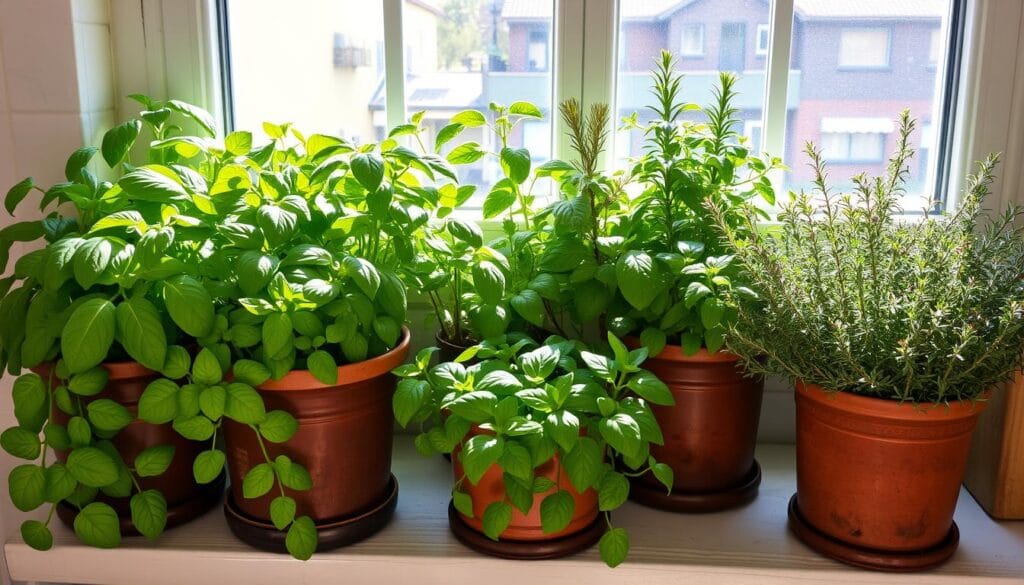
By adding these easy-care plants to your kitchen herb garden, you create a beautiful and functional space. Whether you prefer trailing, compact, or flowering plants, there’s something for everyone. Your kitchen will be perfect for cooking and entertaining.
Soil and Container Selection
Choosing the right soil and container is key for a thriving indoor herb garden. A good potting mix helps prevent waterlogged soil. This is important to avoid root rot and other issues. Use a mix made for indoor plants to keep the soil just right.
It’s also crucial to pick the right container for your herbs. Look for pots with drainage holes to avoid water buildup. Terracotta or ceramic pots are great because they breathe and prevent moisture. Here are some top picks for indoor herb gardens:
- Terracotta pots: breathable and natural, perfect for a culinary herb garden
- Ceramic pots: durable and stylish, great for growing herbs indoors
- Self-watering pots: convenient and low-maintenance, ideal for busy herb enthusiasts
By picking the right soil and container, you’ll grow healthy, tasty herbs. These will make your cooking even better.
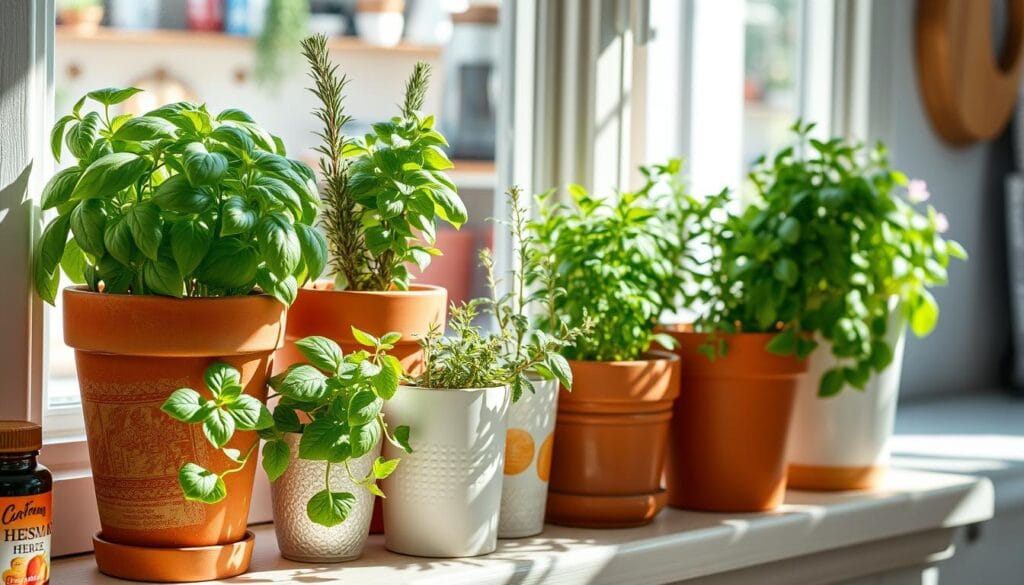
| Container Type | Benefits | Drawbacks |
|---|---|---|
| Terracotta | Breathable, natural, and aesthetically pleasing | Can be heavy and prone to cracking |
| Ceramic | Durable, stylish, and easy to clean | Can be expensive and may not be breathable |
| Self-watering | Convenient, low-maintenance, and perfect for busy herb enthusiasts | Can be more expensive than traditional pots and may not be suitable for all plant types |
Water and Feeding Requirements
To keep your herbs for kitchen window sill thriving, it’s essential to understand their water and feeding requirements. A well-balanced diet and adequate hydration are crucial for the health and success of your indoor kitchen herb garden. Most kitchen herb plants prefer to dry out slightly between waterings, so it’s vital to find the right balance.
When it comes to fertilization, using a balanced fertilizer specifically formulated for herbs is recommended. This will provide your herbs with the necessary nutrients to grow strong and healthy. Be cautious not to over-fertilize, as this can lead to weak and leggy growth. For a thriving indoor kitchen herb garden, consider the following tips:
Watering Schedule
- Check the soil moisture by sticking your finger into the soil up to the first knuckle
- Water your herbs when the soil feels dry to the touch
- Avoid getting water on the leaves to prevent fungal diseases
Fertilization Tips
To promote healthy growth, fertilize your herbs for kitchen window sill regularly. A balanced fertilizer will provide the necessary nutrients for your herbs to thrive. Remember to follow the instructions on the fertilizer package to avoid over-fertilization.
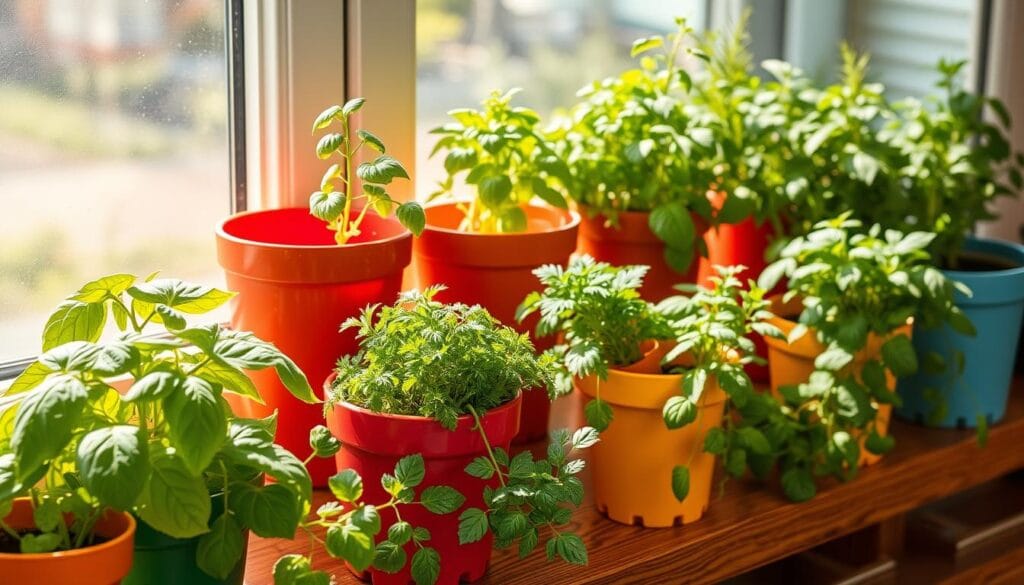
Common Watering Mistakes
Overwatering and underwatering are common mistakes that can harm your kitchen herb plants. Overwatering can lead to root rot, while underwatering can cause stress and reduce growth. By being mindful of your watering schedule and fertilization routine, you can create a thriving indoor kitchen herb garden that will provide you with fresh flavors all year round.
Pruning and Harvesting Techniques
Pruning and harvesting are key to keeping your kitchen plants and herbs healthy. These steps help your plants grow well and taste great. For an indoor herb garden, regular care makes a big difference.
Knowing how to prune and harvest each herb is important. Some, like basil, need pinching, while others, like rosemary, can be cut back. The right techniques lead to a rich harvest from your kitchen plants and herbs.
Here are some tips for pruning and harvesting your kitchen plants and herbs:
- Prune your herbs regularly to encourage bushy growth and prevent them from becoming leggy.
- Harvest your herbs at the right time to ensure optimal flavor and aroma.
- Use the right tools, such as scissors or pruning shears, to avoid damaging your plants.
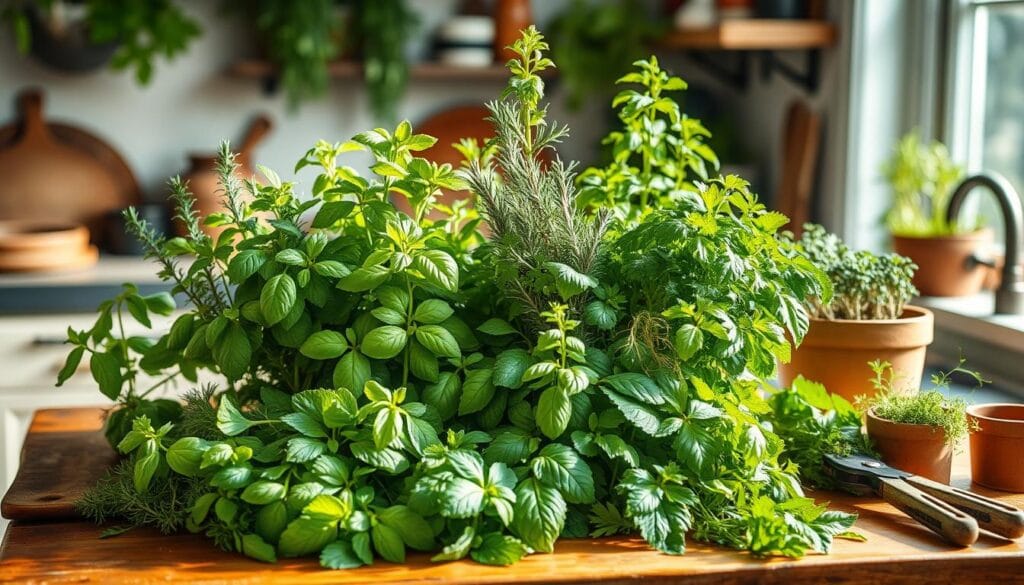
By following these tips and mastering pruning and harvesting, you can enjoy a thriving indoor herb garden. This will make your growing herbs indoors experience even better.
| Herb | Pruning Technique | Harvesting Method |
|---|---|---|
| Basil | Pinch or trim | Pick individual leaves or stems |
| Rosemary | Cut back entirely | Harvest stems or branches |
| Mint | Prune back to encourage bushy growth | Pick individual leaves or stems |
Troubleshooting Common Growing Problems
Even with the best care, a kitchen herb garden can still face growing problems. It’s key to spot and fix these issues quickly. Knowing about pests, diseases, and growth problems is crucial for a healthy garden.
A well-kept kitchen herb garden needs regular checks for trouble signs. Pests like aphids and diseases from too much water can harm plants. Good air flow and careful watering help prevent these issues.

Preventing problems is key. Good air flow, careful watering, and avoiding too much fertilizer are important. Regular pruning and harvesting also help keep plants healthy. By being proactive, you can enjoy a thriving garden and fresh flavors from your herbs.
| Common Problem | Cause | Solution |
|---|---|---|
| Pest infestation | Aphids, whiteflies, spider mites | Use neem oil, insecticidal soap, or introduce beneficial insects |
| Disease | Overwatering, poor air circulation | Improve air circulation, reduce watering, treat with fungicides |
| Growth issues | Inadequate light, poor soil, insufficient watering | Adjust lighting, improve soil quality, adjust watering schedule |
By following these tips and staying alert to growing problems, you can have a thriving kitchen herb garden. Enjoy the best herbs for cooking and other uses.
Seasonal Care for Kitchen Plants and Herbs
As the seasons change, your indoor herb garden needs some adjustments. In spring, give it more light and warmth. This is the perfect time to start growing herbs indoors, like basil and mint, which love the sun.
In summer, your culinary herb garden needs more water and food. Check the soil often and feed your herbs every few weeks. Herbs like rosemary and thyme might need more pruning to stay bushy.
Here are some seasonal care tips:
- Spring: Increase light and warmth, start new herb seedlings
- Summer: Increase water and fertilizer, prune herbs regularly
- Fall: Reduce watering and fertilization, prepare for cooler temperatures
- Winter: Protect from frost and freezing temperatures, reduce watering
By following these tips, your indoor herb garden will stay healthy all year. Watch your plants closely, as some need more care. With the right care, you can enjoy fresh herbs from your culinary herb garden all year.
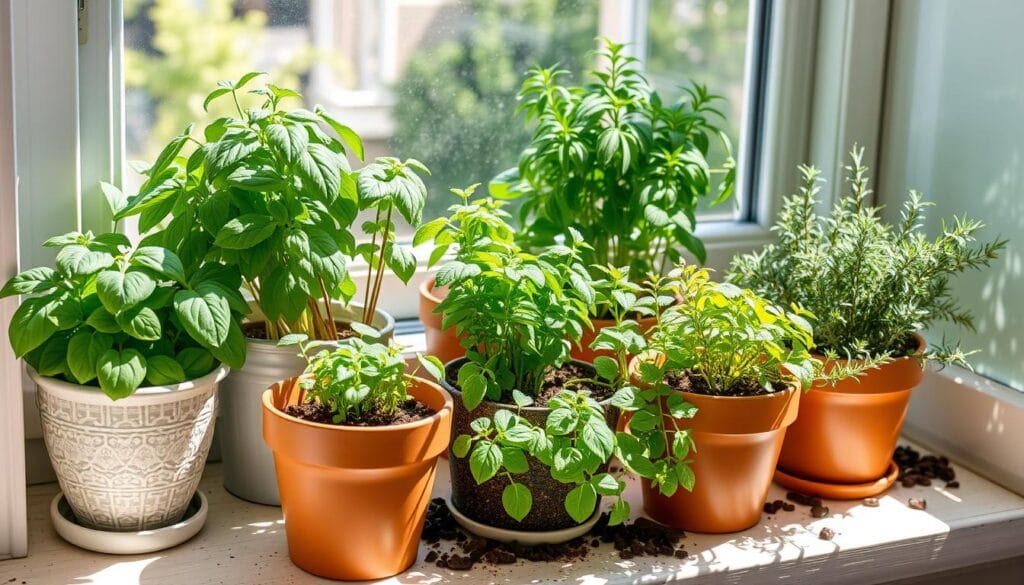
| Season | Lighting | Watering | Fertilization |
|---|---|---|---|
| Spring | Increase | Normal | Normal |
| Summer | High | Increase | Increase |
| Fall | Normal | Reduce | Reduce |
| Winter | Low | Minimal | Minimal |
Creative Ways to Display Your Indoor Garden
There are many ways to show off your kitchen herbs. One favorite is to arrange them on your kitchen window sill. This adds elegance and makes it easy to grab herbs while cooking.
A well-planned indoor herb garden can be a beautiful part of your home. Mix herbs like basil, rosemary, and thyme for a nice look. Decorative containers can also make your garden special.
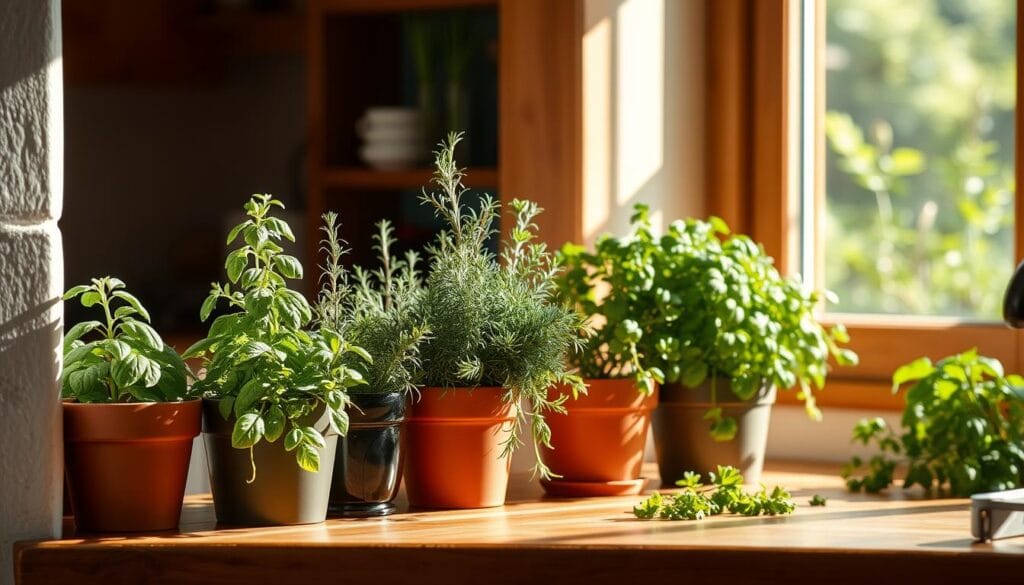
- Vertical gardens: Use a trellis or a wall-mounted planter to create a living wall of herbs that can add a beautiful touch to your kitchen.
- Decorative container ideas: Use unique and colorful pots, planters, and baskets to add a personal touch to your indoor garden.
- Window sill arrangements: Place your plants on a sunny windowsill, where they can receive plenty of light and be easily accessed.
Being creative with your indoor garden can make your kitchen more personal. Whether you prefer modern or traditional, your herb garden will be a beautiful part of your home.
| Display Method | Description |
|---|---|
| Window Sill Arrangements | Place plants on a sunny windowsill for easy access and plenty of light. |
| Vertical Gardens | Use a trellis or wall-mounted planter to create a living wall of herbs. |
| Decorative Container Ideas | Use unique and colorful pots, planters, and baskets to add a personal touch. |
Conclusion
Growing kitchen plants and herbs is rewarding and delicious. With the right tools and care, you can have a thriving indoor garden. This garden will give you fresh flavors and fragrances all year.
Whether you’re new or experienced, there’s always something new to learn. This guide will help you start a vibrant indoor garden. You’ll learn how to pick the best plants and how to prune and harvest them.
So, why not start today? With a little effort and the right knowledge, your kitchen can become a lush oasis. Here, homegrown herbs will make your cooking even better. Enjoy the joy of growing your own herbs and the benefits they bring.
FAQ
What are the benefits of growing kitchen plants and herbs?
Growing kitchen plants and herbs offers many benefits. You get fresh flavors right at your fingertips. It also saves you money compared to buying herbs at the store. Plus, they help purify the air in your home.
What essential equipment do I need for my indoor garden?
For an indoor garden, you’ll need a few key items. Start with a good potting mix and the right containers. Don’t forget a watering system. If your space isn’t sunny, consider a grow light.
What are the best culinary herbs for beginners to grow?
Beginners should start with easy herbs like basil, mint, cilantro, and parsley. These are simple to grow and add flavor to many dishes.
What are some easy-care kitchen plants for decoration?
For decoration, choose easy plants like ivy and creeping thyme. Compact options like rosemary and thyme are also great. For a pop of color, try chamomile and lavender.
How do I properly water and feed my kitchen plants and herbs?
Watering and feeding your plants right is key. Follow a watering schedule and use a balanced fertilizer. Avoid overwatering, which can harm your plants.
How do I prune and harvest my kitchen plants and herbs?
Pruning and harvesting depend on the plant type. Generally, cut back stems to promote bushy growth. Regularly pick leaves or stems for cooking.
How do I troubleshoot common growing problems with my kitchen plants and herbs?
Common issues include pests, diseases, and growth problems. To solve these, identify and control pests, ensure good air flow, and provide the right light, water, and nutrients.
How do I care for my kitchen plants and herbs throughout the seasons?
Seasonal care means adjusting to changes in light, water, and nutrients. As days get longer or shorter, and temperatures change, your plants will need different care.
How can I creatively display my indoor kitchen garden?
Display your garden in fun ways. Try window sill arrangements, vertical gardens, or use decorative containers. These ideas can add beauty to your space.



